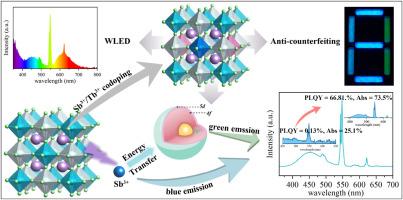稀土基双过氧化物 Cs2NaLuCl6 中的双色发光:Sb3+、Tb3+ 用于暖色 WLED 和防伪
IF 3.3
3区 物理与天体物理
Q2 OPTICS
引用次数: 0
摘要
无铅双包晶石(LFDPs)的发光性能通常较差,而掺杂镧系离子(Ln3+)则是解决这一问题的可行方案。然而,由于半径或价态不匹配,大多数 Ln3+ 离子很难掺入 LFDPs 中。在此,我们成功合成了基于稀土(RE3+)的 Cs2NaLuCl6(CNLC)LFDPs,并通过在 CNLC 中掺杂 Tb3+ 实现了高效的绿色发射。通过建立从 Sb3+ 到 Tb3+ 的能量转移通道,Sb3+ 的引入将 CNLC: Tb3+ 的吸收效率从 25.1% 提高到 73.5%。得益于能量转移,CNLC: 0.01Sb3+, 0.10Tb3+ 荧光粉产生了蓝绿双发射,突出了其在白光发光二极管(WLED)中的应用潜力。此外,还制作出了由 CNLC:Sb3+、CNLC:Tb3+ 和 CNLC:Sb3+、Tb3+ 样品组成的防伪图案,显示了它们在防伪应用中的广阔前景。本文章由计算机程序翻译,如有差异,请以英文原文为准。

Dual-color emitting in rare-earth based double perovskites Cs2NaLuCl6: Sb3+, Tb3+ for warm WLED and anti-counterfeiting
Lead-free double perovskites (LFDPs) usually exhibit poor luminescent performance, and doping lanthanide ions (Ln3+) presents a promising solution to solve this problem. However, most Ln3+ ions face difficulties in incorporating into LFDPs due to the mismatch in radius or valence state. Here, we successfully synthesized rare-earth (RE3+) based Cs2NaLuCl6 (CNLC) LFDPs and achieved efficient green emission through doping Tb3+ into CNLC. Introducing Sb3+ improves the absorption efficiency of CNLC: Tb3+ from 25.1 % to 73.5 % by establishing an energy transfer channel from Sb3+ to Tb3+. Benefiting from the energy transfer, the CNLC: 0.01Sb3+, 0.10Tb3+ phosphor produces blue-green dual emissions, highlighting its potential in white light-emitting diodes (WLEDs). In addition, an anti-counterfeiting pattern composed of CNLC: Sb3+, CNLC: Tb3+, and CNLC: Sb3+, Tb3+ samples was fabricated, which shows their promising prospect in anti-counterfeiting applications.
求助全文
通过发布文献求助,成功后即可免费获取论文全文。
去求助
来源期刊

Journal of Luminescence
物理-光学
CiteScore
6.70
自引率
13.90%
发文量
850
审稿时长
3.8 months
期刊介绍:
The purpose of the Journal of Luminescence is to provide a means of communication between scientists in different disciplines who share a common interest in the electronic excited states of molecular, ionic and covalent systems, whether crystalline, amorphous, or liquid.
We invite original papers and reviews on such subjects as: exciton and polariton dynamics, dynamics of localized excited states, energy and charge transport in ordered and disordered systems, radiative and non-radiative recombination, relaxation processes, vibronic interactions in electronic excited states, photochemistry in condensed systems, excited state resonance, double resonance, spin dynamics, selective excitation spectroscopy, hole burning, coherent processes in excited states, (e.g. coherent optical transients, photon echoes, transient gratings), multiphoton processes, optical bistability, photochromism, and new techniques for the study of excited states. This list is not intended to be exhaustive. Papers in the traditional areas of optical spectroscopy (absorption, MCD, luminescence, Raman scattering) are welcome. Papers on applications (phosphors, scintillators, electro- and cathodo-luminescence, radiography, bioimaging, solar energy, energy conversion, etc.) are also welcome if they present results of scientific, rather than only technological interest. However, papers containing purely theoretical results, not related to phenomena in the excited states, as well as papers using luminescence spectroscopy to perform routine analytical chemistry or biochemistry procedures, are outside the scope of the journal. Some exceptions will be possible at the discretion of the editors.
 求助内容:
求助内容: 应助结果提醒方式:
应助结果提醒方式:


